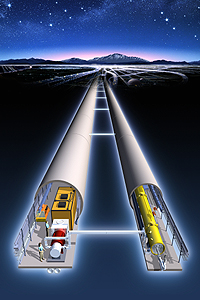Physicists on faculty support ILC construction
By Steve KoppesNews Office
 The artist rendering above shows the 18-plus-miles-long tunnels of the proposed International Linear Collider. (c) Shigemi Numazawa | |
Two beams of subatomic particles, each measuring far less than the diameter of a human hair, travel at the speed of light from opposite ends of an 18-plus-miles- long track. In precise alignment, they smash head-on into each other to simulate the conditions that existed shortly after the big bang.
Particle physicists around the globe nurture this vision for the proposed International Linear Collider, which could lead to revolutionary discoveries about the characteristics of matter and energy. Still at issue: where to build it and to what extent the United States will become involved.
“We haven’t lost yet by building these technological marvels,” said Sidney Nagel, the Stein-Freiler Distinguished Service Professor in Physics and the College. The benefits of accelerator technology to date have included the machines used in radiation therapy and other devices that led to pioneering research in a variety of scientific fields.
“I really view science as all of a piece. You can never really think that working in one area of science is not going to have an effect on something else,” Nagel said. “Physics is trying to understand how nature organizes itself and nature uses the same mechanisms over and over again at different scales of energy and size. Learning about physics at one scale very often tells you about something that happens on another scale.”
Nagel was a member of the National Research Council’s Committee on Elementary Particle Physics in the 21st Century, otherwise known as EPP2010. As a specialist in the study of macroscopic fluids and solids, Nagel was among the committee members who were not particle physicists.
“I sense that he was the scientific gadfly on that committee,” said Mark Oreglia, Professor in Physics and the College. “He asked very tough questions. The committee members assure me that he was the hardest guy to convince, which is good.”
As a member of the U.S. Linear Collider Steering Group, Oreglia has a vested interest in the International Linear Collider. But according to Nagel and his fellow members of EPP2010, so does the entire nation, despite the risks of investing in a multibillion project like the ILC.
“There’s a risk that you take in building this machine, but the risk is far greater if you don’t fund something like the ILC. Not investing money into keeping one of the major branches of physics healthy and viable in this country,” Nagel said, “would be much more dangerous for all the rest of the physical sciences.”
Oreglia regards the EPP2010 review as a unique episode in the history of American science. “Reviews happen all the time, but this panel was very purposefully put together to include elements not only outside the EPP science, but also outside of science altogether,” Oreglia said.
Approximately half of the 22 committee members were not particle physicists. The chair was an economist and former president of Princeton University, and the panel also included a retired CEO of Lockheed Martin Corp., and a longtime veteran of the Office of Management and Budget. Nobel laureate Jerome Friedman (M.S. ’53, Ph.D. ’56) was among the particle physicists on the panel. “It was a re-evaluation of a very expensive science,” Oreglia said. “Is accelerator physics worthwhile? Has it dead-ended? Are the questions worth pursuing at great cost? What’s the impact on the country?”
The committee concluded that the nation had lost its historical prominence in particle physics and would become an increasingly insignificant player in the field unless corrective action is taken. And such action would be needed as part of a broader initiative to strength the nation’s economy through continued technological innovation.
To ensure the nation’s future in particle physics, the committee recommended a budget increase of at least 2 to 3 percent annually after inflation. This would augment U.S. participation in experiments conducted at the Large Hadron Collider in Europe. It also would enable the nation to mount a strong bid to build the next-generation machine—the ILC—on U.S. soil.
When the Large Hadron Collider becomes operational next year, it will become the world’s most powerful accelerator for years to come. “We’re tremendously excited about that machine because clues that we’ve seen in current experiments tell us we’re just on the threshold of new phenomena in particle physics,” Oreglia said.
The committee also ranked particle astrophysics as a priority for future resources and research, noting the emerging connections between subatomic particles and the universe as a whole.
“There’s quite a lot of enthusiasm in Washington now to do this. Just where the money is going to come from, I don’t know,” Oreglia said, “but I am still optimistic.”
![[Chronicle]](/images/sidebar_header_oct06.gif)